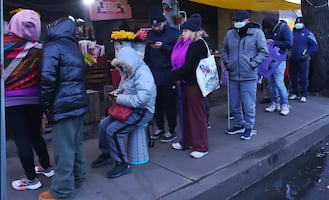In 2020 , the Whitney Museum of American Art in New York will pay tribute to the huge influence of Mexican murals in American art with an exhibition that will gather over 200 pieces , some of which have not been seen for decades in that country.
The cultural institution wants to highlight how the Mexican cultural transformation that took place after the Revolution in 1920 changed the direction of art in the U.S. which turned to pieces with deepe r political meaning and available for all the public instead of only for the privileged.
Among the three most important Mexican artists , the Whitney chose José Clemente Orozco , David Alfaro Siqueiros , and Diego Rivera , whose works of art will be exhibited from February to May 2020 along with other 60 artists both from Mexico and the U.S. to give visibility to the elements that inspired Americans.
“Particularly in the times of the Great Depression , Americans started to see art as an obligation to face society’s problems, and that was an influence of Mexicans,” explained Barbara Haskell , curator of the exhibition to EFE .
Have you heard of
?
“Until then, muralism in the U.S. dragged a very old tradition , with characters wearing Greek clothes and so on,” she added.
Called “ Vida Americana: Mexican Muralists Remake American Art, 1925-1945 ,” the exhibition will be displayed in the fifth floor of the Whitney Museum, something done in rare occasions, and is divided into seven sections, each one focused in an aspect of the Mexican influence .

For instance, Haskell explains that a little known fact is that an artist like Jackson Pollock was inspired by Orozco’s work during years.
“ Pollock made a special journey with his brother in 1930 to see the mural Orozco had painted in the University of Pomona , considered the best painting in the Western world. He took photos that he kept in his study during that decade,” said Haskell.
Did you know
will visit Mexico?
“If you put [pieces] from both of them together, you can clearly see the style influence and the idea of life trauma that Orozco was able to communicate and that Pollock absorbed,” she added.
The detailed exhibition is the result of over four years of research now available to the public in a moment in which the American government has attacked Mexican immigrants.
“15 years ago, it would have changed the understanding of the history of art (…) but now it is much more important because it shows the creativity and vitality that is produced with the free exchange between two countries,” said the curator.
Have you heard of the child prodigy who
?
Along with pieces of Orozco , Siqueiros , and Rivera , the Whitney will exhibit pieces of Pollock , Isamu Noguchi , Philip Guston , Frida Kahlo , and Rufino Tamayo , in addition to works of lesser-known artists from both nations.
Some of the most outstanding pieces are two sketches from 1932 made by Diego Rivera for the famous mural he painted in New York’s Rockefeller Center that was destroyed by those who ordered it for depicting communist elements.
There will also be pieces that have never been seen or that have rarely been exhibited in the U.S., such as Orozco’s “Christ Destroys His Cross” or “Pancho Villa,” and Siqueiros’s “Intertropical” and “Resurrection.”
Did you know the
will be restored in California?
The exhibition is quite relevant at this moment, amidst an anti-migrant policy and with the progress of the project to build a wall dividing both countries . In that sense, Barbara Haskell says “the exhibition shows the power of Mexican art , as well las the creativity and inspiration that result from the free exchange of ideas and persons across borders.”
Vida Americana
is made up of over 200 pieces of over 60 artists from public and private collections. Over 60% of the pieces are easel paintings: there are reproductions of murals created in both countries and with the use of technology, details of the pieces are zoomed in.
For example, explains the assistant curator Marcela Guerrero , they created a video installation that introduces the public to the environment of the Abelardo Rodríguez Market ; there will be reproductions of Orozco’s “ Prometheus ,” Siqueiros’s “ Tropical America ,” and Rivera’s “ The Man Controlling the Universe ” created after the destruction of the mural at the Rockefeller Center. There are reproductions of the mural at Michoacán’s Regional Museum “ The Fight Against War and Fascism ” created by Phillip Guston , Reuben Kadish , and J.H. Langsner in 1935.
Did you know
?
For its part, INBAL has lent 15 pieces from the National Museum of Art , the Carrillo Gil Museum , and the Modern Art Museum . The Anahuacalli Museum is participating with two of Rivera’s studies from 1932 fir the Rockefeller Center mural and another one for his series “ America’s Portrait. ” Another of the great pieces to be exhibited will be a video showing how Rivera created the Detroit pieces. Marcela Guerrero adds: “ Henry Ford , who commissioned the Detroit murals, was obsessed to know all the details and had a cameraman who recorded Rivera the whole time; it’s a gorgeous black and white film.”
There will also be portable frescos, films, sculptures, engravings, drawings, and pictures in nine thematic sections .
Not a story about New York or Los Angeles
“The exhibition,” says Guerrero, “ wants to show that when muralists came to the United States, they worked with many artists from here and so was the migration of ideas about the importance of creating art in walls, in public walls, where people could see it and hence understand those ideas. This is not a history about New York or Los Angeles ; it also includes Detroit , Pomona , New Hampshire ...” She adds that the history of Muralism is not that of a static art : “We tell another story, that of the great dissemination of murals.”
At the beginning of the 20th century , the model known in the United States was the one from Europe , and Americans were looking for their own language: “American art was not famous, what mattered was what Picasso , Duchamp , and Matisse were doing. That is when these artists noticed there was another model, that of Muralists . In the United States, people have not acknowledged the importance and the integrity of having this other model to look at. What excites me the most is to show the public at the Whitney that to understand 20th-century art in the United States , we have to look south, to our Mexican neighbors.”
Did you know
?
Another detail the curators add is the importance Rivera and the rest of the muralists had for Afro-American artists – such as the case of Charles White – and for women like Elizabeth Catlett , who was a member of the Popular Graphic Workshop and who lived and died in Cuernavaca. The same happened to Japanese-American artists like Isamu Noguchi and Eitaro Ishigaki , who worked with Diego Rivera and who is barely known.
Artists like White found in Muralism an option to show social injustice , according to Marcela Guerrero, and Haskell adds: “For Afro-American artists, in particular, Mexican Muralism offered an important model of a kind of art whose topic was the fight against oppression and injustice . They took inspiration from the representation of Mexican history made by Mexicans as a journey from oppression to resistance and freedom.”
Although this art had a great impact, everything changed in the second half of the 20th century . What happened? Haskell answers: “After WWII , abstraction became the dominant model in the United States. Figurative and political art was considered retrograde by the political leaders, who had an enormous influence on the way to appreciate art. As a result, art created by Mexican artists suffered. In addition to this, national themes were suspicious in the post-war years due to the way Nazi Germany had used them to promote a fascist agenda. Finally, Communism became the enemy of the United States after WWII. The association of Mexican artists with Communist ideology reduced its attractive in the country, particularly among conservators.”
Have you heard
?
mp
Noticias según tus intereses
[Publicidad]
[Publicidad]














